The need for clear and reliable communication has driven technology forward for centuries. The longer communication’s reach, the smaller the world becomes. When it comes to cell phones, seamless network coverage and low power draw are the ideals that continually spawn R&D and the eventual deployment of new equipment.
Almost all of us carry a cell phone these days. It takes a lot of infrastructure to support them, whether or not we use them as phones. The most recognizable part of that infrastructure is the communications tower. But what do you know about them?
What Is a Communications Tower?
Communication towers are all around us in various shapes and forms. Some towers serve several kinds of signals. They transmit one-way broadcasts like AM/FM radio and television signals while also handling two-way cellular traffic using various protocols.
Most towers simply elevate and support communication antennas, but there are some called mast radiators that actually act as the antenna themselves. AM radio and other low-frequency towers fall into this category. In this article, I’m going to focus on a particular species of communications tower — the cellular kind.
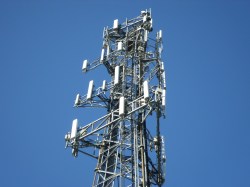
A cell site is mainly two things: arrays of two-way antennas that operate on cellular frequencies, and the equipment that makes that possible. Technically speaking, they are called Base Transmitter Stations (BTS). You might see ‘cell site’ and ‘cell tower’ used interchangeably, but these terms are not synonymous. A cell site or BTS encompasses all the equipment needed to transmit and process cellular signals between devices. This includes the antennas that cover different cellular frequency bands, the signal amplifiers, the on-site processing equipment, and the backhaul connection to the core network. A cell tower is just the structure that elevates the antennas and supports equipment.
The tower itself may be shared by one or more carriers that each has their own cell site. This arrangement is called collocation. Whatever carrier got there first takes the highest elevation for their antennas. Each one that comes after takes the next highest slot. The tower may not be owned by any cell carrier, however. Many of them are owned by companies like American Tower who lease out the space.
Not all cell sites are on towers. Many of them are built on rooftops, and some are perched atop streetlights. Some are designed to go unnoticed, lurking behind facades. They pose as indigenous trees, cacti, steeples, or even art installations. Click to embiggen the disguised sites below.
Masts, Cell Towers, and Cell Sites
There are several types of towers and sites out there. The way that towers look and the heights they reach are determined by the area they occupy and the needs of subscribers on the ground.
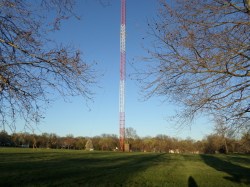
A guyed mast is technically not a tower at all. It’s a narrow latticed structure that is held upright and centered with guy wires that are anchored to the ground. Guyed masts are fairly cheap to construct, but they have a broad footprint and require a lot of land. Because of the way they’re built, guyed masts can reach 2,000 feet tall. Masts over a certain height are usually painted in alternating bands of aircraft orange and white for increased visibility.
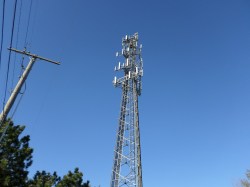
Lattice towers are self-supporting structures that have three or four sides. These are easy to build, easy to climb, and provide a lot of space for mounting equipment.
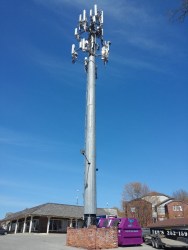
Suburban tower cell site installations are often found on monopole towers. These are sleek poles that look like soaring streetlights with foot pegs. Monopoles are more expensive to build than lattice towers and guyed masts, and they are more difficult for workers to climb. Some of the monopoles in my town have the antennas mounted directly to the pole, which seems like a waste of space.
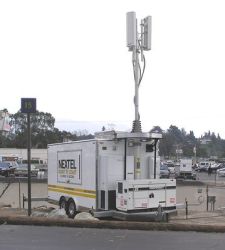
Temporary sites called cells on wheels (COW) are used to handle short-term increases in network traffic. They are often wheeled out for heavy attendance at events like the Super Bowl. COWs are also used in remote rescue and coordinated operations in low or no-coverage locations. These sites are built into vehicles or towed on trailers and come in several shades of functionality.
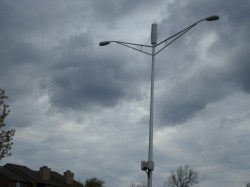
If an area has spotty coverage but the gaps don’t warrant a full-blown cell site, you might spot some street light cell sites. These are part of something called a distributed antenna system, but they are often referred to as small cells. Distributed antenna systems take the power and coverage of a regular cell site and distribute it among several small ones. If a cell site is a cake, a distributed antenna system is a batch of cupcakes. Distributed antenna systems and small cells are also used indoors, usually in busy places like offices, hospitals, and sports arenas.
Bass Drums in the Sky
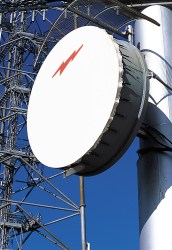
Tower components will vary based on the location and needs of the area’s subscribers, but there are a few things you will see pretty consistently from tower to tower. Most obviously, a cell tower has several types of antennas that handle different frequencies and cellular technologies. These are the thin, vertical bars that are mounted parallel to the tower. Generally speaking, the longer the antenna, the lower the frequency it’s built for. But the physical size of a single antenna says nothing about the traffic capacity of the tower. It’s the number of antennas that determines the amount of traffic a cell site can handle.
Each antenna is connected to the base station by several cables. Monopole towers have a conduit down the center to house the cables, but on a lattice tower, the cables run down the outside. Depending on the installation, they will run over an ice bridge so they are elevated. Base stations can range in size from simple all-weather cabinets to equipment bunkers the size of a small house.

You will often see a parabolic dish or two on a cell tower. It will likely be a grid style or a solid dish, but you might see something that looks like a big bass drum. These are all species of microwave antennas, and they are being used to backhaul traffic to the mobile switch sitting in the central office. If you don’t see any dishes, the backhaul is routing over fiber or copper.
Microwave backhaul antennas come in a couple of flavors. Some are simple, unshielded parabolic dishes like those dark gray ones that receive television signals. Others are shielded with a round radome that protects the antenna from dirt and snow and reduces wind loading. My personal favorites are the ones that look like a bass drum. These are high-capacity, high-performance antennas that can reach 15 feet or more in diameter and weigh hundreds of pounds. Without the drum skin and the rim, they would look like solid parabolic antennas. Those extra things are just a different kind of radome that’s usually made out of fiberglass or Teflon.
Small Boxes, Big Impact
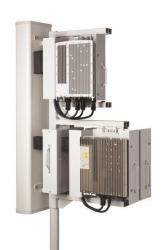
On newer cell site systems, you’ll see a piece of equipment called a Remote Radio Head (RRH). These are used to distribute the base station equipment between the tower and the ground. The RRH itself is a small rectangular box on the tower that is connected to the base station by a fiber optic link. These remote radio heads increase efficiency and free up space on the ground, but there are tradeoffs. They are complex pieces of equipment and they must be built to withstand the elements.
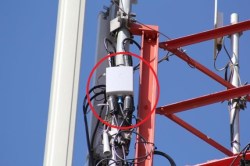
In order to improve the uplink gain, carriers will often mount another small rectangular box called a Tower Mounted Amplifier (TMA). Uplink gain is the transmission of the signal from a subscriber’s handset to the base station. TMAs are great for you and me because our phones are able to communicate with the tower using less battery power and less data. They also give us greater coverage.

Last but not least is the lightning arrester. You can probably guess what this does — it absorbs lightning strikes and offloads them safely to an earth ground. Static dissipative brushes are just one type of lightning protection.
Ground-Level Components
The stuff you see on the tower only makes up half the story. A lot of equipment is necessary to actually route calls and provide the signal in the first place, not to mention the power supply and line rectification. All of this is on the ground at the foot of the tower in cabinets and shelters.
The main components on the ground are the base station transceivers. These are the counterparts for the remote radio heads. Older technologies like 2G and 3G will have their own transceiver, separate from 4G/LTE. A cell site router manages the traffic between the base station transceivers and the mobile switches at the central office. If the backhaul is done over microwave, the shelter will have a baseband microwave processor to handle the signaling.
The rest of the ground equipment is power related—rectifiers that provide either -48VDC or +24VDC and generators to keep things going in times of trouble. Many sites also have battery backup that can last for a couple of hours.

Installation, Maintenance, and Removal
There are hundreds of thousands of cell towers in the United States, and they all have to be inspected regularly. In the past few years, firms have been using drones to take video and high-resolution pictures that can be used to audit the state of the equipment. Installing and maintaining towers is a dangerous job that is both mentally and physically demanding. It’s not uncommon for a technician to start the day on one tower and then drive for several hours to work on another one.
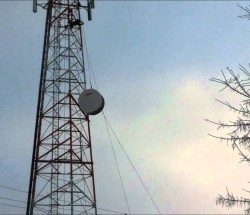
Once a tower is built, the antennas and other equipment are raised up slowly on a rope and pulley system as you can see in this video. If a dish needs to be replaced on a guyed mast, it can’t just be unbolted and dropped. If the dish were to snag a guy wire on the way down, the whole mast could collapse. Here’s a video that shows just how tedious it can be to remove one of those bass drum antennas.
Communications towers are often erected on hills and mountaintops, especially for long-range microwave relay. This height helps ensure that there is a clear path for the line-of-sight propagation required by microwave transmission. If a cell site is already on a mountain or hill, it may not have to be very tall. Unfortunately, this makes the antennas and equipment more vulnerable to the whims of wildlife. Here’s a video showing the damage that an industrious acorn woodpecker or two can cause to a shielded antenna.
The Future of Cell Sites
One way that cell technology is changing is the advent of Device to Device (D2D) technology, also known as LTE Direct. This turns every D2D-enabled device into a part of the transmission network. Essentially, if two D2D-enabled devices are within ~500 line-of-sight meters of each other, they can communicate directly without the need for a base station.
This technology basically turns phones into walkie-talkies that can operate in full-duplex mode. This is great for disaster recovery situations when coverage is crowded or completely compromised. It’s also useful for geofencing, augmented reality, and beacons in retail stores that invite your targeted patronage.
D2D is less battery-intensive than discovery over Bluetooth or WiFi because it takes place at the service layer. And D2D’s privacy is better than cloud-based methods because it’s not continuously tracking your device’s location. In that case, the future looks pretty good.


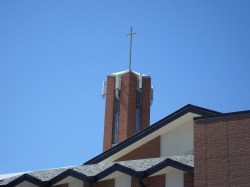

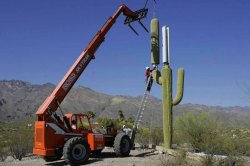

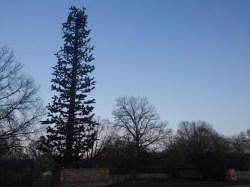














Your information about the typical guyed lattice tower max height is a little off, There are many of them that are over 2000 feet tall. Currently the Burj Khalifa Tower is just shy of 2800 feet tall.
What the heck? Burj Khalifa isn’t an antenna tower. It’s a building.
With a big antenna atop of it ;-)
UMmm no dude, the Burj Khalifa Tower is a building. The Warsaw Radio Tower is the highest guyed lattice tower at 2119.42 foot(according to G00gl3). So the article is spot on. “OVER 2000 feet tall”
Buildings can be towers too yah know. “A tower is a tall structure, taller than it is wide, often by a significant margin.”
The name is not Burj Khalifa building, but tower ;)
The clue is in the word ‘guyed’. Guy wires are the wires/cables stopping the mast from falling over or buckling.The Burj Khalifa is not guyed.
https://en.wikipedia.org/wiki/Guyed_mast
Whenever I see this kind of conversation with multiple people completely failing to notice or interpret a qualifier I wonder whether their reading comprehension is just that bad, or if they literally ignore words they don’t know.
Some people suffer from Actualitis. When the opportunity to correct someone on a technicality occurs it causes some people to stop reading the rest of the article and begin typing a comment, often starting with “Actually, …”.
Ignorance is simultaneously incapable of noticing itself and unable to refrain from alerting others of its existence. It’s a potent combination of failure and ridicule that, in some cases, can be mercifully self-pruning.
The operative word here is ‘guyed’. The Burj Khalifa tower does not have guy wires for support and therefore is disqualified from this grouping.
We’re talking Communication Towers and not AM/FM transmitters. Most cellur antennas are located ~180’ above ground.
I seen one the other day like none of these it had large things like ten by twelve wide I don’t know what it is should have gotten a pick maybe military
This makes me think of the crazy conspiracy theories about these “mysterious towers” and mind control.. oh and also chem trails for some reason.
https://www.youtube.com/watch?v=tfG9zljgFh0
A very good example of Dunning-Kruger effect ?
https://en.wikipedia.org/wiki/Dunning%E2%80%93Kruger_effect
Whoa, I didn’t know there was a name for this but this very accurately describes this behavior. Just listen to the way she talks so confidently
I think that most engineers suffer from the corollary “highly skilled individuals may underestimate their relative competence and may erroneously assume that tasks which are easy for them are also easy for others”.
Truth!
I think many engineers suffer from “highly skilled individuals (in one area), may overestimate their relative competence outside their area of expertise.”
Also: “I can’t understand why you do what you do, therefore the most likely explanation is that you are stupid/irrational, not that I am missing something.”
Nope. Just paranoia and delusion. It’s sad to see, really. She needs mental help.
On the plus side, it looks like she should have good cell coverage.
Dunning-Krueger is like how I think I could probably fly a commercial airliner. How hard can it be?
Obviously a Trump supporter! But it’s ok, because no one is a bigger friend to silent weapon system victims than Donald J. Trump. Believe you him. He will be tougher on silent weapon system conspirators, aka the Democratic Party, than anyone in the history of being tough on silent weapon system conspirators…. He will make smart meters great again. He will abolish the Federal Chem Trail Program along with the EPA. And balance the deficit by making cell phone tower disguisers pay for it all. DJT in 2016!
He never said any of those things. He is a man of accomplishments, of which you know nothing.
Yeah all these loose and fast facts compared to Clinton who practically created ISIS by meddling in middle-east intelligence, mostly illegally, and represents the ‘less free speech’ and ‘more government regulation’ millennial movement..
And she leaves people to die instead of answering the phone at 3am…
And blatently disregards federal law and wipes an email server in the middle of an investigation…
Lies about being shot at…etc etc. The list is endless.
I agree that Trump may not be the best choice, but let’s not ignore the facts to pretend Hillary is better.
That’s something you don’t usually see in elections. Typically they pander to a specific class (Middle, High, etc), or race (White, Black, etc), or religion/belief system (Christian, Racist, etc), but I’ve never seen a politician seek out the untapped “Conspiracy Theorist” demographic. Maybe that could pay off?
Its too bad she said August 1st. Her ramblings would fit a lot better on April 1st.
Those theories are rubbish.
The real conspiracy is that these towers are put up by government, sometimes in the form of LEO with stingray, but also actual full scale towers, in order to spy on citizens and visitors.
Look into it, it isn’t a conspiracy theory, it is another conspiracy fact. One well known sign you have been logged on to one of these spying towers is a degraded signal (to 3G). Another sign is that you are on federal property, where this seems most common.
It is known once you are paired with a tower in this way, your phone is essentially open for automated data collection – but they really want your contact list, call history, location history.. Well heck, they apparently take it all.
I think I;ve been doing to much radio work. I was thinking “Why the hell would someone build a cell tower in Low Earth Orbit?”
likewise… might tough to steer that sucker!
Seems to me that she should be immune to mind control, because it appears she has no mind to control.
Complains about being irradiated…is out at noon in California sun.
Don’t forget the plastic owls we put on the towers to frighten off woodpeckers and other birds that damage equipment.
http://www.hamradio.com/detail.cfm?pid=H0-000126
Wow, you learn something new every day.
Woodpeckers were famous for making nests in the feedhorns of our C-Band and Ku-Band satellite uplinks.
You have any idea how gross it is to clean out the feedhorn of cooked woodpecker?
Free lunch!
I bet it tastes like chicken only a little more gamey.
So this silly animals did not know, that they would taste much better properly fried than just microwaved? :-)
Don’t forget squirrels!
https://www.youtube.com/watch?v=cZkAP-CQlhA
I see that and all I can think of is Chip and Dale swearing.
Hell I’m sure I heard them swearing.
My experience is they rarely work for more than a short period of time.
I’ve found them knocked off towers with a big Osprey or similar nest at the top.
Seem them, tried them. They still loose effectiveness after a while. And like I said, I’ve seen them knocked down with an Osprey or similar bird’s nest at the top.
Once that happens, there aren’t many anythings that will try to populate the tower lest they be turned into food… but then we can’t climb if there are birds in the nest.
http://media.gettyimages.com/photos/brazen-seagulls-pigeons-and-starlings-bask-in-the-afternoon-sun-by-a-picture-id136942837
Interesting article, thanks for publishing it!
I never quite understood why companies go through so much trouble to “hide” radio towers. They’re not fooling anyone, and to me a metal lattice tower looks far better than a stupid fake pine tree (common around here). Of course, as a ham I may be a bit biased when it comes to antennas.
Usually because the local homeowners group (aka bunch of power hungry busybodies) demand it to keep *their* neighborhood free of ‘eyesores’
Good point. Too bad we can’t remove the power-hungry busy-bodies instead of the antennas…
They can effectively be dislodged with explosives. Sadly, archaic federal and state regulations prohibit this.
It is THEIR neighborhood where they live, and they ARE eyesores.
You disagree?
Yup, I disagree completely. Your rights to have a pretty back yard end at your property line. Antennas aren’t eyesores, they are functional structures that benefit the whole community, unlike your pretty back yard and assumption of property values (based on anything but actual reality) which benefit only the very selfish owner of said pretty back yard.
I agree they find them to be eyesores, but eyesores aren’t harmful to one’s health. No need to stare at them raiding ones blood pressure, an eyesore is more preferable to a constant odor or noise that there is no escape from.
Some big corporation operating at 0% tax and run by men born rich wants to put huge ugly public paid but private profiteering infrastructure up, sometimes literally ‘in your back yard’…
Of course citizens resist. You think they put these in expensive hoods? No. You are complaining about people trying to maintain their very average property values.
So, in your sick view of humanity, having money and using it to create jobs is somehow evil? Who’s your employer? Are they evil too? Or do they get a pass because they sign your paycheck?
Property values are a myth. Your property rights end at your property line. You have no right to dictate what happens beyond that line unless it poses a safety or health risk to the entire community. Antennas do neither.
Busybodies, on the other hand, pose a mental health risk to the surrounding communities…
As for which “hoods” get cell towers, poke around on Google Earth a bit. I’ve seen cell towers behind $5M homes in Southern California, and a large number of the cell towers here in the northeast are smack in the middle of expensive hillside properties.
Get over yourself already.
Oh, and enjoy your excellent cell phone coverage, courtesy of these “eyesores” in your neighborhood.
The most ridiculous one in this area is there is a section of Highway 18 in the angeles mountains that was hit by a forest fire some years ago, clearing the entire area of pine trees.
Seems the cell tower company didn’t get the memo, so their “disguised” Pine treetenna is the biggest, most visible thing for at least 500 meters in any direction.
Perhaps these people still think that when playing peek-a-boo the person actually vanishes?
Hey, never know. Schroedinger’s cat might still be kicking around in its quarters. :D
So a tower costing some many hundreds of thousands of dollars to build is just supposed to burn away like the trees surrounding it… just in case someone might complain it’s the only thing still standing?
Or are you just saying that no one knew it was there until it survived the fire?
“Perhaps these people still think that when playing peek-a-boo the person actually vanishes?”
Reality is perception, no?
They have no cogent point. They only have vapid indignation – like disliking the color of the emperors coat.
They didnt even condemn the appearance of the antenna itself so much as make a nonsensical tirade!
I enjoyed both reading and discussing it. Thx.
my guess is that it burned and they put the same design back there
NIMBY
Not In My Back Yard
Mostly it’s the liberal Democrats that use the majority of the services but don’t want any of the accountability responsibility regarding what has to occur in order to make them happy.
They bitch about not having cell coverage but won’t let you build a site anywhere near them.
Reminds me of a house I walked by once it had a big sign on the lawn that said “Leave Fossil Fuels in the Ground” and an Escalade in the driveway!
You actually think only ‘liberals’ are opposed to private corporations putting up high-profit infrastructure in their residential areas, thereby directly lowering the visual appeal of the area?
OK man.
In general, cell sites aren’t put up in residential areas unless the usage within the area warrants it. Then, most every attempt is made to conceal the site, visually at least. It might be set back at the center of the roof of a local market, or hidden within the local 7-11 or Circle-K sign; maybe hidden in the scoreboard of the local school’s playfield.
Regardless, you might see it going up, but after a bit you’ll only see it when you’re looking for it. If you don’t know it’s there, you’d be hard pressed to find it… if the jurisdiction pushes “stealthing” for the install.
A while back, the company I worked for installed a site at a parking garage directly under the approach to Lindberg Field / San Diego. We pulled a few of the residents over and asked them to find the antennae and they couldn’t do so until we pointed directly at the antennae. Funny thing is one of the walls was an Ansel Adams mural and the antennae were mounted on it- we blended the antennae into the mural so that unless you had a very off-angle view you’d have to study hard to find them.
Done similar at the Beverly Hill Police station too. ;)
Just last month I watched a neighborhood near me show up at city hall with torches and pitch forks when they town announced it had already been working with a tower company for 2 years to install a Verizon tower at the edge of a secluded wooded park near the neighborhood. The comments in our online paper were pretty much worthless “think of the kids, you’re exposing them to RF”, but most comments there are worthless anyway. It’s easy to see why camoflage is practically required even in the suburbs now. Honestly it’s not a bad idea anyway to camoflage cell sites, you don’t need weirdo’s show up and burrying “tower busters” under them: http://www.metatech.org/danger_of_cell_phone_tower.html
That’s an ignorant use og broad brush. I live in Brownbackastan (KANSAS) Those complaining most about visual aesthetics and their affects on property value most likely vote republican an think of themselves as conservatives.
I’ve worked in wireless site development for over 2 decades in FL and I can tell you 100% that’s incorrect.
You literally have no idea what you’re talking about. I’ve been at “Community Meetings” as part of zoning approval and the City Commission, County Commission, Board of Zoning Adjustment, etc. meetings.
My favorite is when they don’t use their brain when designing such things.. On I10 in Southern California, most of the cell towers are disguised as palm trees.. But there’s one, out there in the desert that’s disguised as a pine tree…
I live in SoCal, and I do know what you’re saying, but most aren’t palms, though there are many of them. Many are pines, redwoods and such.
For every palm you see, there are 3-6 other sites you don’t.
We now have a choice in SoCal–pine tree, palm tree, or “wooden” water tank. The tank almost had me fooled, until I realized there was no standpipe. And yes, we live in the desert too, and a pine tree is pretty incongruous in our area. But the birds appreciate it.
I think the real problem is that the companies often don’t go to very MUCH trouble to “hide” them. The fake trees look really fake… but considering how good some of the fake Christmas trees are nowadays, it’s not because it’s impossible to make a decent looking fake tree. It’s just that the tower companies don’t actually want a good-looking fake tree, they just want one that plausibly looks like they tried to disguise it but costs as little as possible, with the key metric being “will we get away with this when someone complains to the planning and zoning commission?” The end result looks worse than just dropping a naked tower down on the site.
A much better hidden cell tower design I’ve seen in a city is a monopole with internal antennas that has a massive U.S. flag attached, appropriately scaled to the diameter of the monopole. That last part is the genius of it; from a distance, it doesn’t seem that big, because it looks “right” compared to the “pole.” Up close, you realize it’s big enough that you could spread it on the ground and build a decent two-story house on its footprint.
The problem with the flagpoles is their RF footprint. Having the antennas inside of the tower makes the distance and distance of the signal degrade. Not the case on a regular monopole, lattice or guy wire tower. So while the flagpole looks better, you’re actually ending up with more towers that way.
Also, hard to believe earlier comments come from people that don’t know a building can be called a “tower” without being a tower. There are tons of condos here in FL with names like Gulfstream Towers, but they’re just condos full of rich elderly people.
The most hidden cell tower I have ever seen was inside an bell tower, the cell company removed the metal stairs, shaved the bricks (to reduce attenuation). And technically because the façade structure existed already they did not need to apply for planning permission, in that particular district.
This has become a significant source of income for some inner city churches facing shrinking congregations.
I lived in a very pro-military community (pretty much everyone was employed by the Navy or the plethora of companies that supported the Naval facilities in the area, so understandable). So a lot of the towers were disguised as giant mono-poles with no external equipment except for a pulley and rope to hang massive American flags on them (The flags were at least 2.5-3 meters tall).
After a few years, you could see where the antennas were since they had plastic covers attached that discolored at a different rate than the painted metal pole.
Yeah, that’s a problem since the paint has to have a very low metallic pigment concentration.
The rest of the pole’s usually painted with something high in zinc to retard corrosion.
Most cell towers also have a GPS antenna for clock discipline which is really important in getting connecting phones locked to the carrier and correcting their local TCXO drift.
We use individual GPS antennas for each AP serving wireless internet customers. I’d like to see us investigate the use of local HD radio signals for clock, but that’s just a weird thought brought on by a previous HaD post.
wouldn’t the other side of those APs be connected to the internet and thus be able to ntp? or ptp if you needed that level of precision?
They need usec precision for TDMA; i.e synchronizing many AP.
I love these articles. Thanks. You mention that most cell sites have battery backup that will last for a couple of hours. Do they also usually have a generator to handle longer outages? It seems to me that those systems need to be able to run for as along as possible during emergencies as people rely more and more on cellular communication for everything.
All the towers I’ve seen and worked with have large fuel tanks and generators attached to the base building/box to keep the power on for the equipment, which is always plugged into a battery backup (UPS), and to run the air conditioning constantly. This is for wireless shots for commercial broadband net fed by fiber. The AT&T colocations are the same way, so It’s safe to bet that the rest of the cell sites are similar.
The “reasonable” norm is that a particular site will run 4-8 hours on back-up batteries, depending on the technology involved and usage.
Realistically, cell access won’t be any better than POTS / land line access in case of a wide-spread situation. Previously hardened terrestrial MW relays have been or will be decommissioned leaving no redundancy.
Depending on the actual fault, entire segments of the cell networks could be rendered inaccessible if not for power interruption, backhaul interruption could be just as critical.
I’ve seen some cells designed were only a small percentage of towers will be given generators, and when they are switched to generator power, they’ll shut off everything except 2G and crank the power way up to cover the area the other towers would cover. Or they’d switch to voice-only and only allow calls to a small list of numbers (Emergency numbers, public utility’s reporting numbers, other public services, etc) in order to conserve energy.
The unspoken fact is the general public should NOT expect to have normal cell phone seric in the event of a major disaster. if they live near a large population center. Government and responders get priority use of the cell phone network. In fact the plan is to build first responder needs atop the cell phone infrastructure. Look up first net. While first net is about a broad band network, protocols for standard cell phone use have been in place for years again. Government and first responders have priority. When the general public get access it wil be limited to time slots. The bad thing id that emergency management is telling the public this so the public cab prepare to make the best use of their time to inform distant family of their status and keep track of family within their area.
BTS = Base Transceiver Station
What you’re calling “DAS” are what I know as either “repeater” or “micro cells”, or “string” sites. They are typically low power, well under 25W and sometimes under 5W, and may or may not be extensions of another site known as a “macro cell” or “donor” cell.
Some of the early ones like those found along popular winding roads simply repeated the signal from one sector of a donor cell up and down the route. Typically, the donor site BTS was configured for 4 sectors, with the 4th sector being converted from RF to digital then distributed out to the repeaters over copper or fiber where it was converted back to RF and broadcast. There were no provisions for pole-to-pole hand-off since each pole broadcast the exact same signal; the only hand-offs possible were either from the repeater closest to the donor BTS or the repeater furthest from the BTS to the nearest adjacent cell.
Later ones became micro cells of one or more sectors and acted like mini sites that could hand off calls from one to the next instead of simply broadcasting one signal from every location along the route. This increased the call traffic capacity on these roads since one pole only served the distance necessary to pick up or hand off a call to the next. These micro cells may be controlled by switching / routing equipment in a macro cell, or may route back to the network control center.
Other variants include “relay” or “extender” sites which are removed from the donor site. These work more in line with what you might call a repeater, but there is channel conversion going on. The extender might pick up a phone on one channel then relay the call to the distant donor over another channel, in effect a “man in the middle”. Common uses are to provide service to a small area where it’s not practical to install a full BTS, like to service a small valley or to provide “over the hill” coverage along an otherwise well covered route in order to fill a small hole in coverage.
Now, when I hear DAS, I think of an antenna network in a high-rise building or such, where serving the building from external cell sites is impractical because of the size of the building or its construction. Since many antenna have a very limited vertical beam, it would take many antennae at multiple elevations to service the building from outside. Also, some buildings’ construction isn’t conducive to external coverage either: thick concrete floors and support structures, metallized window coatings, metal framed walls, tons of EMI from lighting and so on.
DAS, in many ways, are similar to the micro cell concept: multiple sectors distributed around the building. It also is typically carrier agnostic, though a carrier might initiate a build at a location. The equipment permits multiple carriers to share the same antenna system so whomever gets there first can lease the system to others.
Yes! Scrolled down to see if anyone else caught the BTS. +1 for you!
Her voice is a very effective human eradication mechanism. 10 more minutes and I may kills myself.
“But what do you know about them?”
Uh, quite a bit actually. Was a broadcast engineer for roughly half of my four decade career.
Was surprised you didn’t mention much about ice. Best sheild for roof tops is a layer of sidewall sllt tires (to prevent water buildup) covered with chain link fencing. Still gets your attention when a fifty pound hunk of ice falls 280 feet and hits sheild.
And all of these towers, guyed lattice or other has a huge design fault, THE light bulb at the TOP that requires replacing every so often ! If the guy that designed the bulb at the top had to change one or two the bulb would be much easier to maintain and most likely would be at ground level and a light pipe would take the photons to the towers top! (my opinion, which comes from a fear of FALLING from heights, NOT the height itself!),
You may have a business idea here. How expensive is it to run someone up a tower like that? Times how many such towers? I see dollar-signs.
When praticing 100% tie off climbing the tower is perfectly safe. The towers need to be inspected anyway so going up to change the bulb isn’t a big deal. A quadcopter can only do so much, it’s only a visual check. A full inspection requires checking for loose bolts or cables.
I bet an advocate of it would tell you all these problems will be solved by the Internet of Things.
Smart bolts that tell you their torque in realtime, light bulbs that notify you when they’re going out, cables that…tell you other things. I’m sure that will be along once they finally figure out how to get your fridge to re-order milk properly.
NICE TO HAVE NOW MILLIONS OF SMALL CELLS AND HUNDREDS OF THOUSANDS OF 5G TOWERS GRILLING BEES, ANIMALS, PEOPLE AND NATURE ALIVE.
IT’S LIKE BEING INSIDE A GIGANTIC MICROWAVE OVEN AND PRETENDING IT’S ‘CONSPIRACY THEORY’ WHILE SLOWLY BEING MICROWAVED.
SINCE MARCH 2020, THE ONLY THING THAT HAS NOT GONE DONE IS THE INCREDIBLE LEVEL OF HUMAN STUPIDITY.
WE WANTED TO SAVE ‘HUMANITY’ ONCE, UNTIL WE UNDERSTOOD THAT MOST OF SO-CALLED ‘HUMANS’ ARE STUPID, IGNORANT, COWARDLY CATTLE WHO LOVE NOTHING MORE THAN WEARING MUZZLES, GETTING INJECTED WITH SHIT, EATING AND DRINKING JUNK AND WAITING FOR THE NEXT ORDERS FROM THEIR MASTERS.
SO, GRILL MORONS, WE WILL SIT BACK, RELAX AND WATCH YOU BE MICROWAVED AND STILL DON’T UNDERSTAND WHY….
Don’t forget the old WeCo microwave horns used in the AT&T Long Lines network http://www.engineeringradio.us/blog/wp-content/uploads/2009/07/western-electric-microwave-antennas.jpg
I recognize many of those towers; many are in Johnson County, KS.
The street light microcell is at 112th and Metcalf in Overland Park, KS. The tower with the glass recycling dumpster is 95th and Mission. The AM tower is 75th and Mission, and is an unwanted signal in my HF radios.
Now if my wife re-arraigned the furniture in my house, I would not recognize it.
I see not even HaD is free from the mindless bickering that typically inhabits comment sections on other sites anymore.
All the complainers are free to turn in their cell phones and go back to using landlines, you hypocrites! :)
I like that you talked about how communication towers are all around us in various shapes and forms. I was reading a pretty fascinating book earlier and it was all about how telecommunication systems work. According to the book, it seems there are cell tower lease acquisition companies now.
I’m posting a constructive comment for once/ The disguised cell site on a church looks like it’s on a Church of Jesus Christ of Latter Day Saints meetinghouse(to use the building’s proper name, and yes, I belong to that church).